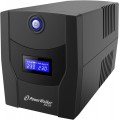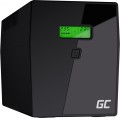Half load operating time
UPS continuous operation time from a fully charged battery when connected to a load with a power equal to half the output power of the UPS (maximum or effective, depending on the type of load, see below for details). The operating time with such a load is much longer than for a full load, and even in the simplest models it can reach 20-30 minutes.
Switching to battery
The time required to transfer the load from mains power to battery power. In standby and
interactive UPSs (see Type), a short-term power failure occurs at this moment — accordingly, the shorter the time to switch to the battery, the more uniform the power supply is provided by the source during a power failure. Ideally, the switching time for the traditional 50 Hz AC frequency should be less than 5 ms (a quarter of one cycle of the sine wave). With inverter UPSs, the transfer time is, by definition, zero.
Output voltage accuracy
This parameter characterizes the degree of difference between the AC voltage at the output of the UPS and the perfect voltage, the graph of which has the shape of a regular sinusoid. The perfect voltage is so named because it is the most uniform and creates the least unnecessary load on the connected devices. Thus, the distortion of the output voltage is one of the most important parameters that determine the quality of the power received by the load. A distortion level of 0% means that the UPS produces a perfect sine wave, up to 5% — slight sine wave distortion, up to 18% — strong distortion, from 18% to 40% — a trapezoidal signal, more than 40% — a square wave.
Efficiency
Efficiency (coefficient of performance) in the case of a UPS is the ratio of its output power to the power consumed from the network. This is one of the main parameters that determine the overall efficiency of the device: the higher the efficiency, the less energy the UPS wastes (due to heating parts, electromagnetic radiation, etc.). In modern models, the efficiency value can reach 99%.
Socket type
A socket for a specific type of plug in the UPS design.
—
Type F (Schuko). A traditional European socket with two round holes in the center and grounding contacts in the form of two metal brackets (at the top and bottom of the socket). The term Schuko stuck to this type of socket due to the abbreviation from the German Schutzkontakt - protective contact.
—
Type E (French). The French style socket has two round holes and a protruding ground pin just above them in the center. The standard has become widespread in France, Poland and Belgium (along with the traditional type F sockets).
—
Type G (British). The plug for such sockets consists of two flat horizontal pins and one flat vertical pin for grounding. The standard is found mainly in the countries of the United Kingdom, Malta, Cyprus, Singapore and Hong Kong.
—
Type B (American). American-style sockets are designed for plugs with two flat prongs and a semicircular grounding contact. Type B is widely used in regions with voltage 110 - 127 V - USA, Japan, Saudi Arabia, etc.
Total battery capacity
The capacity of the battery installed in the UPS. For models with multiple batteries, this is both the total working capacity and the capacity of each individual battery: the batteries in such devices are usually connected in series, so that their total capacity corresponds to the capacity of each individual cell.
Theoretically, a higher battery capacity means the ability to power loads of a given capacity for longer. However, in fact, this parameter is more of a reference than practically significant. The fact is that the actual amount of energy stored by the battery depends not only on the capacity in amp-hours, but also on the voltage in volts; this voltage is often not specified in the characteristics, despite the fact that for accurate calculations it must be known. So when choosing, you should focus on more "close to life" characteristics — first of all, on the directly claimed operating time in different modes (see above).
Battery type
The type of battery installed in the UPS.
—
Fiberglass (AGM). An advanced type of lead-acid battery with electrolyte in an adsorbed state: the compartments of such a battery are filled with porous material, which contains acid. At the same time, the battery case is sealed and AGM models are maintenance-free. This technology is the most popular in batteries for uninterruptible power supplies: it is ideal for batteries operating in buffer mode (that is, when they rarely need to be discharged and, as a rule, little by little). In addition, it provides a long service life, and AGM batteries are inexpensive. The disadvantages of this option include the impossibility of replenishing the electrolyte if it leaks, as well as poor tolerance to overcharging (although the latter becomes irrelevant with a high-quality power controller).
—
Gel (GEL). A type of lead-acid battery that uses a gel electrolyte. GEL batteries are best suited for operation in cyclic mode - that is, when the battery needs to power the load for a long time, discharge almost to zero, then charge and again provide long-term autonomous power. But for the buffer mode, in which most UPSs operate (standing on standby for a long time in order to briefly maintain power supply in the event of a failure), this technology is not suitable for a number of reasons. Therefore, it makes sense to purchase such batteries only in cases where t
...he “uninterruptible power supply” has to be turned on almost every day - for example, in unstable networks with constant and long-term power outages.
— Lithium-ion (Li-Ion). The key advantages of lithium-ion batteries are high capacity with small dimensions and weight. Also, Li-Ion batteries are not subject to the “memory effect” and can charge quite quickly. Of course, this option is not without its drawbacks - first of all, it is sensitive to low and high temperatures, and if overloaded, the lithium-ion battery can catch fire or even explode. However, thanks to the use of built-in controllers, the likelihood of such “emergency” situations is extremely low and, in general, the advantages of this technology significantly outweigh the disadvantages.
— Lithium iron phosphate (LiFePO4). An advanced modification of lithium-ion batteries (see above), designed to eliminate some of the shortcomings of the original technology. Lithium iron phosphate batteries are characterized by a large number of charge/discharge cycles, chemical and thermal stability, low temperature tolerance, short charging time (including high currents) and safety in operation. The likelihood of an “explosion” of a LiFePO4 battery when overloaded is reduced to almost zero, and in general, such batteries cope with high peak loads without problems and maintain the operating voltage almost until they are fully discharged.Protection
The protection functions provided in the design of the UPS.
—
Short circuit protection. A short circuit is a sharp drop in load resistance to critically low values, due to which the current strength increases and the UPS experiences significant overloads that can disable the device and even cause a fire. It may be caused by a problem with the connected device, poor insulation, foreign objects, etc. In the event of such a situation, the short circuit protection system turns off the UPS, preventing unpleasant consequences.
—
Overload protection. Overload in this case is the excess of the load power consumption over the output power of the UPS. Working in this mode can also lead to unpleasant consequences up to breakage and fire; to avoid this, a protection system is installed that turns off the UPS when an overload occurs.
—
Overcharging protection of external battery. The overcharge protection function prevents the accumulation of excess energy in the battery, from which the UPS operates in autonomous mode. Overcharging is highly undesirable for any type of battery. It can lead to various unpleasant consequences - from deterioration in performance to overheating and fire of the battery. The automatic protective equipment on board the uninterruptible power supply turns off the power after the battery is fully charged. This prevents “extra” curre
...nt from entering the battery, which could damage it. This system is convenient in that the battery can be left on charge for a long time without fear of overexerting it.
— Noise filtering. A system that suppresses high-frequency interference in an electrical network — these can be either single voltage surges when turning on and off powerful electrical appliances, or long-term interference from constant sources, such as electric motors. These interferences can adversely affect the operation of electronics connected to the network (up to visible failures); the noise filtering system avoids this. Such systems are quite simple, and therefore most modern UPSs are equipped with them.
— Data line protection. High-frequency interference protection system, similar to interference filtering (see above) — only used not in an electrical network, but in a telephone or wired computer (LAN) network. Such networks are also subject to interference from various sources of electromagnetic radiation, which can cause failures of equipment connected to them: PCs, printers, fax machines, etc. UPSs with this feature have at least two LAN standard connectors (input and output), into which appropriate network or telephone (with RJ-11 connectors compatible with LAN) cables are inserted.
— Emergency cut-off. This connector allows you to connect the UPS to an emergency power off system. Thus, in an emergency (for example, in the event of a fire), the entire room, including and with a power reserve, can be completely de-energized by pressing one button. Without this, the UPS would simply switch to battery when the power goes out and leave the equipment energized, which could lead to disastrous consequences.
— Sound alarm. A system that gives an audible signal in various important situations. It is most commonly used to signal a power outage and the UPS is transferring to battery power. Without a sound signal, this could not be noticed at all (the light is not always on in the room, it goes out when the network fails, the contact in the socket itself may disappear, etc.), which is fraught with a sudden shutdown of the equipment, data loss and breakdowns. Also, sound alarm can be used for other events — low battery, end of charge, bypass on / off, etc.Fuse
Fuses are used to protect the UPS from a critical increase in current strength: at the right time, they open the circuit, preventing unpleasant consequences. Today, these types of fuses are used.
— Melting. At a critical current strength, the conductive element in such a fuse melts and opens the circuit. The fusible protection is disposable, after operation such a fuse must be replaced.
— Automatic. Such a fuse has a sensor that monitors the current strength and opens the contacts at the right time. Its main difference from fusible is reusability: after operation, the circuit can be closed again with literally one press of the button on the fuse.

